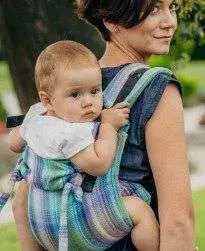Moms from Asia have used Meh Dais to carry their babies for ages. This type of baby carrier is a hybrid created by coupling the strength of a structured baby carrier with the simplicity of a baby wrap. You can make your own meh dai (also called mei tai, but meh dai is more culturally correct) or buy one online or wherever. But how do you use a meh dai to carry a baby?
How to Use a Meh Dai to Carry Your Baby
You can use a meh dai baby carrier to give your bundle of joy a safe back carry, a hip carry, or a front carry that fosters parent-baby bonding.
But that’s not all.
It’s also possible to nurse your baby in a meh dai. Once you’re done nourishing the baby, you should adjust the meh dai so that it reverts to its initial snug, high position. Watch this video to learn how to nurse your baby in a meh dai.
In how to wear a meh dai baby carrier, you’ll learn how to do wear your baby on the back, around the hip, and in the front.
Is It Okay to Use a Baby Carrier for a Newborn?
It’s not a good idea to wear a baby in a meh dai or any other kind of baby carrier if they’re too young. If your baby is younger than 4 months, their little necks aren’t strong enough to support their lovely domes, yet. With necks that are tender and weak, there’s always going to be a neck injury risk to some degree.
The baby carrier market swarms with all kinds of baby carriers for newborns. Some of the options are marketed as being good for even one-day-old tots.
But according to Stanfordchildren.org, it’s unwise to use a meh dai or any other carrier type for sick babies and low-birth-weight twins and triplets. It’s best to have a consult with your pediatrician before using any type of carrier to wear vulnerable tots.
Your Baby’s Safety is Paramount
The Consumer Product Safety Commission gives clear babywearing safety guidelines. According to the CPSC, make sure you’re seeing your tot’s nose and mouth all the time. Always wear your baby high enough so that you can see their face.
Also, make sure to review the manufacturer’s carrier use instructions. If a carrier is designed for older babies with stronger necks, don’t use it for newborn babies.
At no time should you let the baby’s chin touch the chest. Nor should the baby’s face press too closely against your body. That’s how baby carrier suffocation happens. Also, you should not put a blanket or cover of any kind over the head of your baby.
What Activities Can You Do When Wearing a Baby?
One reason moms and dads use baby carriers is that this piece of baby gear allows them to use their hands for other activities. But according to the CPSC, it’s not safe to run, jog, drive, ride a bike, take part in a sport, jump on a trampoline, or even cook near a hot surface when carrying a baby.
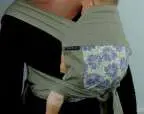
So, what activities are safe with your baby on your body? Follow this simple safety rule: Avoid doing anything you would not do with your baby in your arms. That’s pretty straightforward.
Now that that is out of the way, let’s learn how you can safely wear your baby in a meh dai.
How to Do the Front Carry With a Meh Dai
Before you start using your meh dai, be sure to learn the recommended tying style. There are two meh dai waist tying styles namely:
- The apron style
- The non-apron style
Apron vs. Non-Apron Style
With the apron style, you secure your carrier around your waist pretty much the way you would an apron. The apron meh dai tying style gives your tot a comfortable deep seat and is what to use if you’re carrying a smaller baby. Because the apron style makes the panel a little shorter making it suitable for smaller babies.
With this style, you don’t see the waistband because it’s sandwiched between yourself and your baby. There’s no folding the waistband here.
As for the non-apron style, use it when you want the panel to be somewhat taller. If you’re wearing a taller, bigger baby, this style works somewhat better. What’s more, the non-apron style translates into better baby weight distribution around your waist or hips.
Here, you fold the waistband once toward yourself, and after you wear the baby, the band is easily visible. Because the band sits below your baby’s bum.
Determine what style the manufacturer recommends for your meh dai. Meh dais with a padded waistband generally favor the non-apron tying method. Those with unpadded waists typically come with apron-style tying instructions. So, always check the manufacturer’s instructions.
1. How to Tie a Meh Dai for the Front Carry (Apron Style)
Here’s how to tie a meh dai in the apron style. Here’s a video on how to tie the apron style. This method keeps you and your baby close and connected.
1. With the patterned side of the panel facing toward your body and shoulder straps, tie the waist straps (around your waist). Remember: the patterned panel is facing outside at this point. Also, the waist strap labels and the instructions panels are visible from the outside.
Be sure to tie the straps around your natural waist. Your natural waist should be somewhere around your belly button. See how you start the process in the picture below. This is the Infantino Sash that moms everywhere love.
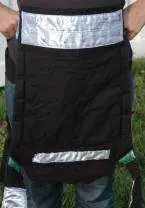
2. Use a double knot to tightly secure the waist straps on your back.
3. Take your baby and place them high on your chest with the legs open and knees comfortably bent. See the image below to understand how to correctly hold your baby. One hand should hold the backside while the other supports the top part.
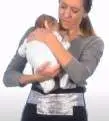
I suggest that you use a doll initially and practice this step until you’re comfortable doing it with your baby.
Don’t Drop that Baby!
4. Holding the baby securely with one hand. use your free hand to lift the hanging end of the carrier over the baby’s body. Drape the meh dai’s shoulder straps over your shoulders so that the straps now hang down your back.
5. Now, hold your baby with your dominant hand (right hand for yours truly). Use the other hand to reach behind your back and grab the shoulder strap from the opposite shoulder. Place the strap over your baby and switch hands. The hand that went for the strap is now holding the baby. And the other hand goes for the other strap.
6. Tie the two straps around the front using a double knot. But you don’t want the knot too tight as to squeeze your baby. You’re to make the knot right across the middle of your kiddo’s back as shown in the image below.

7. If you did it correctly, the shoulder straps should make the letter X on your back as shown below.
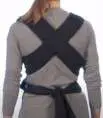
8. Hold your baby’s head gently and turn it to one side. You’re doing this to make sure your kiddo can breathe without hindrance.
What If Your Baby is Older and Bigger?
Go through all the steps outlined above. But when lifting the baby, hold them tummy to tummy with their legs wrapping around your waist. The baby is now in the facing-in position.
If the shoulder straps are extra long and you’re not a big mom or dad, you can tie them at the back. Instead of making the double knot on the front, cross the straps one over the other while holding the baby with one hand.
Pass one of the straps over the baby’s bum and then underneath the leg and repeat for the other strap. Finally, tie them at the back somewhere above the first knot and you’re done! It’s that simple and easy.

10. Optional: What if the meh dai has a hood and you want to use it? If it’s cold outside, you can attach the detachable hood to protect your baby.
Take the hood and snap the base to the matching points on the carrier near the shoulders. Finally, attach the hood’s straps onto the matching snaps on the shoulder straps.

How to Use the Non-apron Style
The non-apron tying style distributes your baby’s weight toward your hips. To achieve that baby weight distribution, you tie the straps around the top of your hips. The waistband sits somewhere below your toddler’s bum, distributing their weight toward your hips.
Unlike with the apron style, the waistband isn’t visible after you’re done wearing your baby. In this method, you fold the waistband once toward your body before proceeding with the rest of the tying process.
2. How to Back-carry Your Baby in a Meh Dai
The back carry isn’t for newborn babies. You want to use it for bigger babies (8 months and above). Here’s how to do tie a meh dai for a back carry:
1. Place the carrier flat on your body with the shoulder straps and panel handing down. Like in the front carry style above (apron style), the decorated panel should be facing toward your body. Then, tie a double knot around the front over your natural waistline.

2. Bend down forward and place the baby on your back with the legs wrapping around your waist. Practice with a doll first or have someone put the baby on your back.

3. Pick the panel and bring it up over the baby so that you have a nice deep seat. The shoulders should drape over your shoulders and hang down the front.

4. Criss-cross the straps over your chest and then run the ends over the back of your baby. Finally, pull the straps around the front and make a secure double knot.
3. How to Tie a Meh Dai for a Hip carry
Like the back carry, the hip carry isn’t for newborns. You want to use this carry style for a baby that can sit without help. I’m talking about at least a 6-month baby here. Below are the steps to follow:
1. Place the meh dai flat on your hip and make a double knot on the opposite hip.

2. Then pick up your baby and put them on the carrier. Make sure the legs are sticking out, hugging your waist. And their hips are should stay nice and comfortable. Keep the legs somewhat higher than the backside.
3. Holding your baby securely, bring the panel (the patterned side of the panel should be facing your hip) back up.
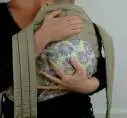
4. Take the front strap and drape it over your shoulder down the back.

5. Still holding the baby, use the hand opposite the draped shoulder strap to pull it down a bit for a tighter carry.

6. With the free hand, find the other shoulder strap sitting behind your arm. Pass this strap under your arm and press that arm to hold the strap down.

7. Pull the strap under your arm right across your back. To execute this step successfully, switch to the hand whose arm you’re pressing on the strap with. You should end up with a letter X on your back, but it’s not a perfect X.

8. Bring the strap across the front, over the baby’s legs, and tie a double knot under the bum.

9. To prevent the strap over the shoulder from digging into your neck and causing discomfort, adjust it a bit. Move the strap outward until it’s sitting just outside your shoulder.
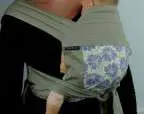
How to Hip, Back, and Front-carry a Baby in a Meh Dai: Conclusion
A meh dai is like a simpler structured baby carrier or a complex baby wrap. If you tie your meh dei correctly, you’re sure to end up with a nice, secure carry.
With this Asian-style baby carrier, you can wear your baby on the hip, on the front, or on the back. I’ve explained in detail and with pictures how to wear your baby on all three locations.
What remains is for you to put to work what you’ve learned so you can get closer with your baby. Happy babywearing!
I'm Esther Moni, a proud stay-at-home mom and a psychology graduate of the United States International University (USIU) . I hate it when anyone calls me a housewife, because what does housewife even mean? Being a mother of two babies and a pup, Bailey, as well as being Ricky's wife tires me to no end, but I still manage a smile at the end of it all. And when my boys aren't done doing mischief, I juggle writing a post on parenting or baby gear performance for this blog and running my little counselling office based out in Nairobi. <a href="https://www.facebook.com/esther.moni/">Visit my Facebook profile here</a>, and this is my <a href="https://ke.linkedin.com/in/esther-moni-3841b573/">LinkedIn profile</a>, and here's my <a href="https://www.youtube.com/channel/UCKcVb3NNDrURDH8C0KiAE1g/">nascent youtube channel.
